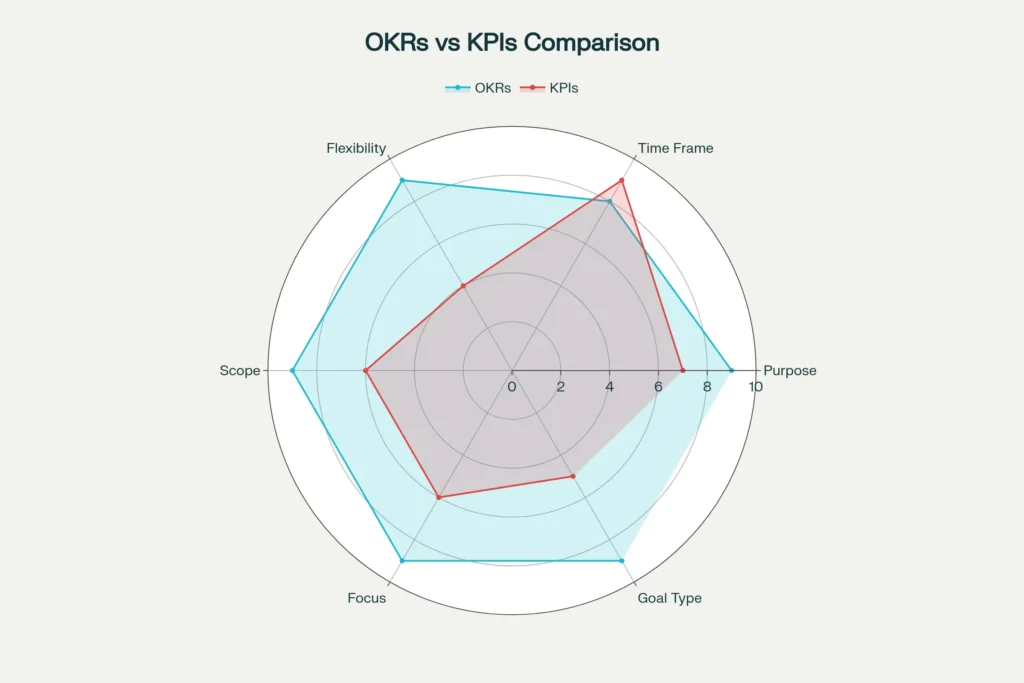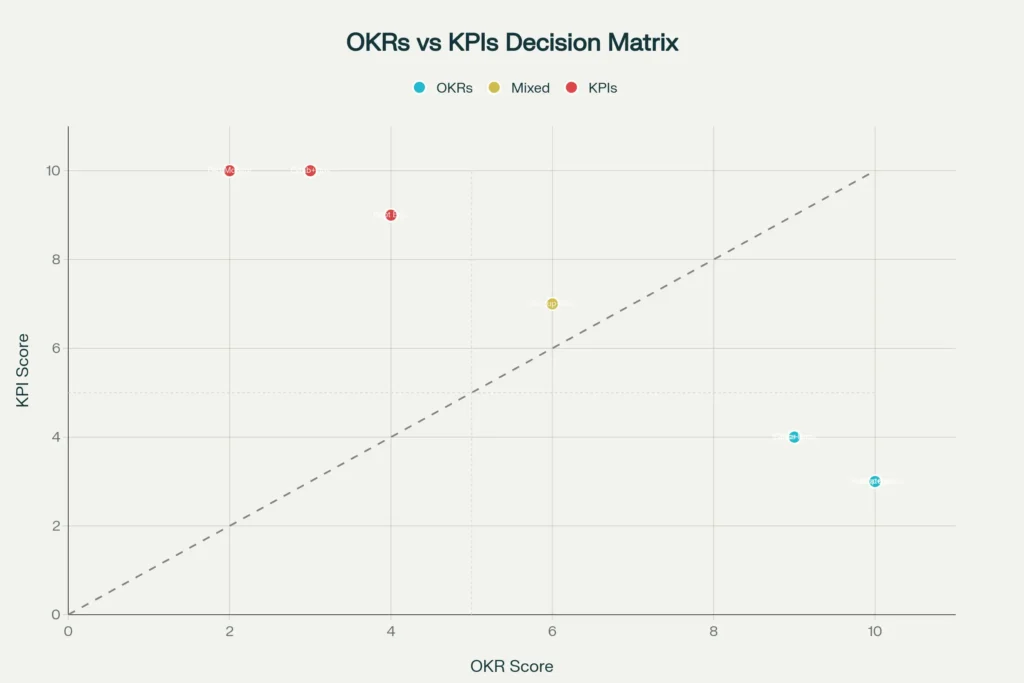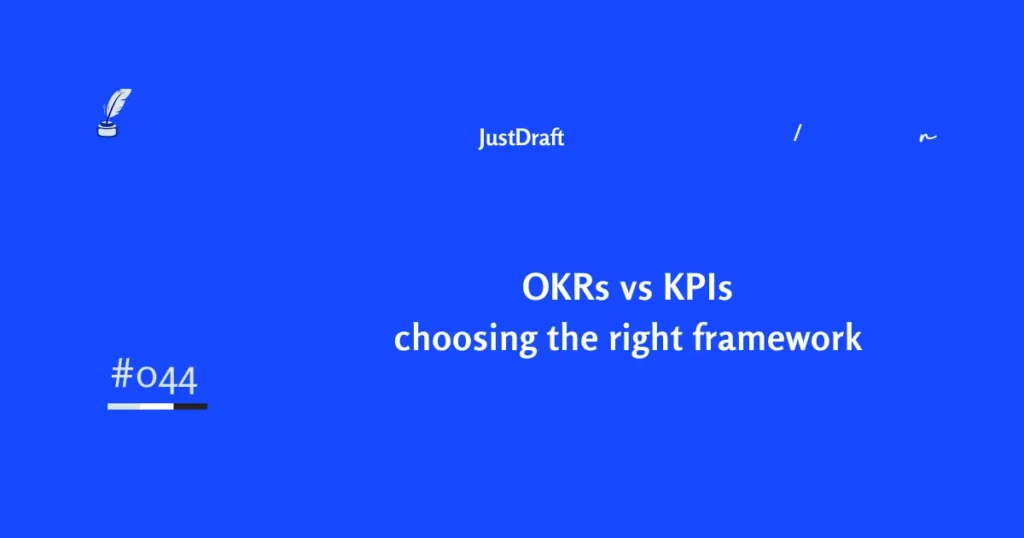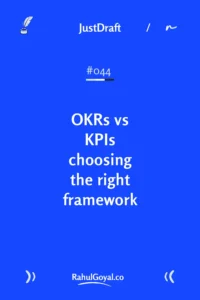When to Use OKRs vs KPIs for Team Success
If you’ve ever sat in a meeting arguing whether to set objectives or metrics, you’re not alone. Goal-setting is one of the most debated topics in leadership. Everyone agrees on the importance of clear goals—but which framework actually works better: OKRs (Objectives and Key Results) or KPIs (Key Performance Indicators)?
Here’s the truth: both matter. But they do very different jobs.
One Topic: OKRs vs KPIs
The Real Difference (Beyond the Jargon)
Think of OKRs as your North Star – they point you toward ambitious destinations you want to reach. KPIs? They’re your speedometer, telling you how fast you’re currently going.
The Case for OKRs
Think of OKRs as your strategic compass. They point you toward bold change.
- They combine an inspiring objective with measurable key results.
- Most companies run them quarterly, making them perfect for innovation and transformation.
- They’re built for stretch goals. In fact, teams often aim to hit 60–70%, not 100%.
Example: A startup wants to break into a new market. Their OKR might be “Become a top-3 player in Spain this year”. Key results could be “Sign 50 enterprise clients” and “Achieve 20% brand recognition”.
It’s ambitious. It forces teams to think bigger.
The Case for KPIs
KPIs are your dashboard gauges. They measure whether the engine is running smoothly.
- They track ongoing performance against clear benchmarks.
- They don’t change much over time—think revenue per customer, churn rate, or project delivery timelines.
- They ensure consistency, efficiency, and accountability.
Example: A logistics company might monitor KPIs like “Average delivery time under 48 hours” or “98% on-time shipments”.
They don’t set direction, but they keep the wheels turning.

When to Use What
Choose OKRs when:
- You’re launching something new
- Your team needs to think bigger
- You want cross-department collaboration
- Change is your friend, not your enemy
Stick with KPIs when:
- You’re running proven processes
- Consistency matters more than innovation
- You need clear accountability
- Your stakeholders want predictable metrics
Here’s what most people miss: You don’t have to choose sides. The smartest leaders I know use both. OKRs for the big picture, KPIs for the dashboard.

How to Get It Right
- Don’t overload. Track 3–5 OKRs per quarter, and 5–7 key KPIs. More than that, and focus gets diluted.
- Assign ownership. Every KPI and OKR needs a name next to it. Accountability drives results.
- Stay flexible. OKRs aren’t meant to be rigid. Revisit them often as realities change.
- Celebrate progress. Highlight small wins to build momentum and avoid fatigue.

The Bottom Line
Research indicates that companies using structured goal-setting approaches show a 39% higher likelihood of achieving their objectives, yet 71% of organizations report they haven’t fully mastered their chosen framework. The framework doesn’t make you successful – how you use it does.
Companies that write down their goals perform 76% better than those who don’t. Whether you call them OKRs, KPIs, or just “important stuff to track” matters less than actually tracking them.
The best approach? Start with what fits your culture. Growth-stage companies usually love OKRs. Established operations often prefer KPIs. But don’t be rigid – let your needs guide your choice.
What framework is your team using right now? Hit reply and let me know what’s working (or not working) for you.
Read last week’s LensLetter newsletter about World Photography Day & Camera Through Time.
Interested in travel, Read last week’s JustDraft about Our New Book “The Clarity Playbook” Announcement.
Two Quotes to Inspire
A leader without clear measures is a traveler without a map.
Strategy sets the pace, but measurement sets the standard.
One Passage From My Bookshelf
Measurement matters. If you can’t measure it, you can’t manage it. The Balanced Scorecard was designed not just to track financial performance, but to balance it with measures of customer satisfaction, internal processes, and learning and growth. Leaders who use this framework don’t just count results—they shape future performance by linking vision to day-to-day actions. This alignment creates the bridge between strategy and execution.
📚From The Balanced Scorecard by Robert S. Kaplan and David P. Norton

